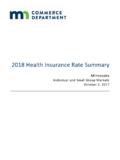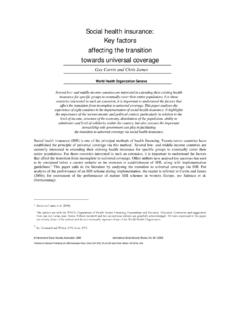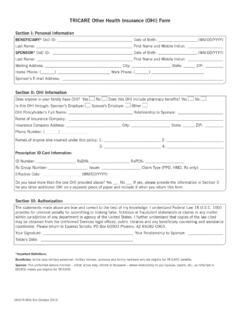Transcription of Health Insurance Benefit Mandates in California State and ...
1 Health Insurance Benefit Mandates in California State and Federal Law November 30, 2012 This document has been prepared by the California Health benefits Review Program (CHBRP). CHBRP responds to requests from the California Legislature to provide independent analysis of the medical, financial, and public Health impacts of proposed Health Insurance Benefit Mandates and repeals. Updates to this list of Health Insurance Benefit Mandates current in California ,1 as well as additional information about CHBRP, can be found at Purpose of this list: This list is intended to alert interested parties of existing State and federal Health Insurance Benefit mandate laws that may relate to the subject or purpose of a proposed State -level Health Insurance Benefit mandate or repeal bill. Benefit Mandates listed: CHBRP defines Health Insurance Benefit Mandates as per its authorizing Therefore, the listed Mandates fall into one or more of the following categories: (a) offer or provide coverage for the screening, diagnosis, or treatment of specific diseases or conditions; (b) offer or provide coverage for types of Health care treatments or services, including coverage of medical equipment, supplies, or drugs used in a treatment or service; and/or (c) offer or provide coverage permitting treatment or services from a specific type of Health care provider.
2 Listed Mandates also include those that (d) specify terms (limits, timeframes, copayments, deductibles, coinsurance, etc.) for any of the other categories. Table 1 includes California s State -level Health Insurance Benefit mandate laws, and Table 2 includes federal Health Insurance Benefit mandate laws. Information included for listed Mandates : Table 1 identifies relevant California statutes. The table specifies when the law Mandates an offer of coverage for the Benefit . The table also identifies which Health Insurance markets (group and/or individual) are subject to the mandate . Explanations of these terms are provided in Appendix A. Table 2 identifies relevant federal statutes, both those in existence prior to passage of the Patient Protection and Affordable Care Act (ACA) as well as federal Mandates in the ACA. Like Table 1, Table 2 identifies the Health Insurance markets subject to the mandate .
3 Because none of the federal Mandates are Mandates to offer coverage, this information is not included in Table 2. 1 Available at: 2 Available at: Current as of 11/30/12 2 Other important information: Not all Health Insurance is subject to State -level Health Insurance Benefit mandate laws. CHRBP annually posts estimates3 of Californians sources of Health Insurance , including figures for the numbers of Californians with Health Insurance subject to State -level Benefit Mandates . California has a bifurcated legal and regulatory system for Health Insurance products. The Department of Managed Health Care (DMHC) regulates Health care service plan contracts, which are subject to the Health and Safety Code. The California Department of Insurance (CDI) regulates Health Insurance policies, which are subject to the California Insurance Code.
4 DMHC-regulated plan contracts and CDI-regulated policies may be subject to State -level Benefit mandate laws, depending upon the exact wording of the law. DMHC-regulated plans and CDI-regulated policies may also be subject to federal Benefit mandate laws. Federal Benefit Mandates may interact or overlap with State -level Benefit Mandates . Some known interactions are noted in the footnotes for Table 1. Federal Benefit Mandates can apply more broadly than State -level Benefit Mandates . For example, federal Benefit Mandates may apply to Medicare or to self-insured plans. Table 2 only lists federal Benefit mandate laws that would be relevant to DMHC-regulated plans and CDI-regulated policies. DMHC-regulated Health plans are subject to minimum Benefit laws and regulations (also known as Basic Health Care Services ) that may interact or overlap with State -level Benefit mandate laws.
5 The Basic Health Care Services requirement for DMHC-regulated Health plans is noted in Table 1 and further explained in Appendix B. Although CHBRP assesses the impacts of bills, not existing laws, CHBRP s analysis of Assembly Bill 1214 (2007)4 required a review of mandate laws current at that time. That report and all other CHBRP analyses may be found at 3 Available at: 4 Available at: Current as of 11/30/12 3 Table 1 California Health Insurance Benefit Mandates 5 (by Topic) # Topic Health and Safety Code (DMHC) California Insurance Code (CDI) mandate to Offer ?6 Markets (regulated by DMHC or CDI) Subject to the mandate mandate Category DMHC-Regulated Health Care Service Plan Minimum benefits 0 Health Plans regulated by the Department of Managed Health Care (DMHC) are required to cover medically necessary basic Health care services, including: (1) Physician services; (2) Hospital inpatient services and ambulatory care services; (3) Diagnostic laboratory and diagnostic and therapeutic radiologic services; (4) Home Health services; (5) Preventive Health services; (6) Emergency Health care services, including ambulance and ambulance transport services, out-of-area coverage, and ambulance transport services provided through the 911 emergency response system; (7) Hospice care.
6 See Appendix B for further details. Multiple Sections See Appendix B N/A7 Group and Individual Not a distinct mandate Essential Health benefits 1 In 2014, a federal mandate will require some plans and policies to cover essential Health benefits (EHBs) and will place limits on cost sharing. These statutes define EHBs for Small Group9 and Individual10 In 2017, Large Group sold via the Exchange11 a, b, d 5 CHBRP defines Health Insurance Benefit Mandates as per its authorizing statute, available at: This list includes laws that meet that definition and are known to CHBRP. 6 mandate to offer indicates that all Health care service plans and Health insurers selling Health Insurance subject to the Benefit mandate are required to offer coverage for the Benefit . The Health plan or insurer may comply: (1) by including coverage for the Benefit as standard in its Health Insurance products, or (2) by offering coverage for the Benefit separately and at an additional cost ( , a rider).
7 See Appendix A. 7 N/A indicates that the Benefit mandate does not apply to products governed under that code. 8 Affordable Care Act (ACA), Section 1301, 1302, and Section 1201 modifying Section 2707 of the Public Health Service Act (PHSA). See Table 2 below. 9 The ACA defines a large group as >100 employees. California State law defines a large group as >50. However, the ACA [Section 1304(b)(3)] allows states to treat groups between 50 and 100 as large for plan years beginning before 2016. Current as of 11/30/12 4 # Topic Health and Safety Code (DMHC) California Insurance Code (CDI) mandate to Offer ?6 Markets (regulated by DMHC or CDI) Subject to the mandate mandate Category Cancer Benefit Mandates 2 Breast cancer screening, diagnosis, and treatment Not Specified12 a 3 Cancer screening tests Group and Individual b 4 Cervical cancer screening Group and Individual a 5 Mammography Not Specified a, c 6 Mastectomy and lymph node dissection (length of stay, complications, prostheses, reconstructive surgery) Not Specified b, d 7 Patient care related to clinical trials for cancer Not Specified d 8 Prostate cancer screening Group and Individual a Chronic Conditions Benefit Mandates 9 Diabetes education, management, and treatment Not Specified a, b, d 10 Diabetes education N/A Offer Not Specified (CDI) a 11 HIV/AIDS, AIDS vaccine Group and Individual (DMHC), Not Specified (CDI)
8 A 12 HIV/AIDS, HIV Testing Group and Individual a 13 HIV/AIDS, Transplantation services for persons with HIV (a) Not Specified d 14 Osteoporosis Not Specified a 15 Phenylketonuria Not Specified a Hospice & Home Health Care Benefit Mandates 16 Home Health care (non-HMOs only13) Offer Group b, d 10 The EHB coverage requirement will apply to nongrandfathered plans and policies sold outside of the exchange as well as to qualified Health plans (QHPs, see ACA Section 1301) certified by and sold via an Exchange. 11 Effective 2017, states may allow large-group market qualified Health plans (QHPs, see ACA Section 1301) to be certified by and sold via an Exchange [ACA Section 1312(f)(2)(B)].
9 Large group QHPs would be subject the EHB coverage requirement. 12 Not Specified indicates that the Benefit mandate does not specify which market or markets are subject. 13 DHMC regulates some non-HMOs ( Health maintenance organizations) Insurance products, including some PPOs (preferred provider organizations). Only non-HMOs are subject to this Benefit mandate . Current as of 11/30/12 5 # Topic Health and Safety Code (DMHC) California Insurance Code (CDI) mandate to Offer ?6 Markets (regulated by DMHC or CDI) Subject to the mandate mandate Category 17 Hospice care N/A Group (DMHC) b 18 Dementing illness exclusion prohibition Group and Individual a, d Mental Health Benefit Mandates 19 Alcohol and drug exclusion prohibition N/A Group (CDI) d 20 Alcoholism treatment (a) Offer Group a 21 Coverage and premiums for persons with physical or mental impairment 10144 Group and Individual a, d 22 Coverage for persons with physical handicap N/A Offer Group (CDI) a, d 23 Coverage for mental and nervous disorders, including care provided by a psychiatric Health facility N/A 10125 Offer Group (CDI) a 24 Care provided by a psychiatric Health facility 1373(h)(1) N/A Not Specified (DMHC) b, d 25 Nicotine or chemical dependency treatment in licensed alcoholism or chemical dependency facilities (b)
10 Offer Group b, d 26 Coverage for severe mental illnesses (in parity with coverage for other medical conditions)14 Not Specified a, b, d 27 Prohibition on Determining Reimbursement Eligibility from Inpatient Admission Status Not Specified d 28 Prohibition of Lifetime Waiver for Mental Health Services 10176(f) Individual a, d 29 Behavioral Health treatment for autism and related disorders Not Specified b Orthotics & Prosthetics Benefit Mandates 30 Orthotic and prosthetic devices and services Offer Group b 31 Prosthetic devices for laryngectomy Not Specified b 32 Special footwear for persons suffering from foot disfigurement Offer Group b 14 In addition to these State -level Benefit Mandates , the federal Mental Health Parity and Addition Equity Act of 2008 requires that if a group plan or policy covers mental Health , it must do so at parity with coverage for medical and surgical benefits .






